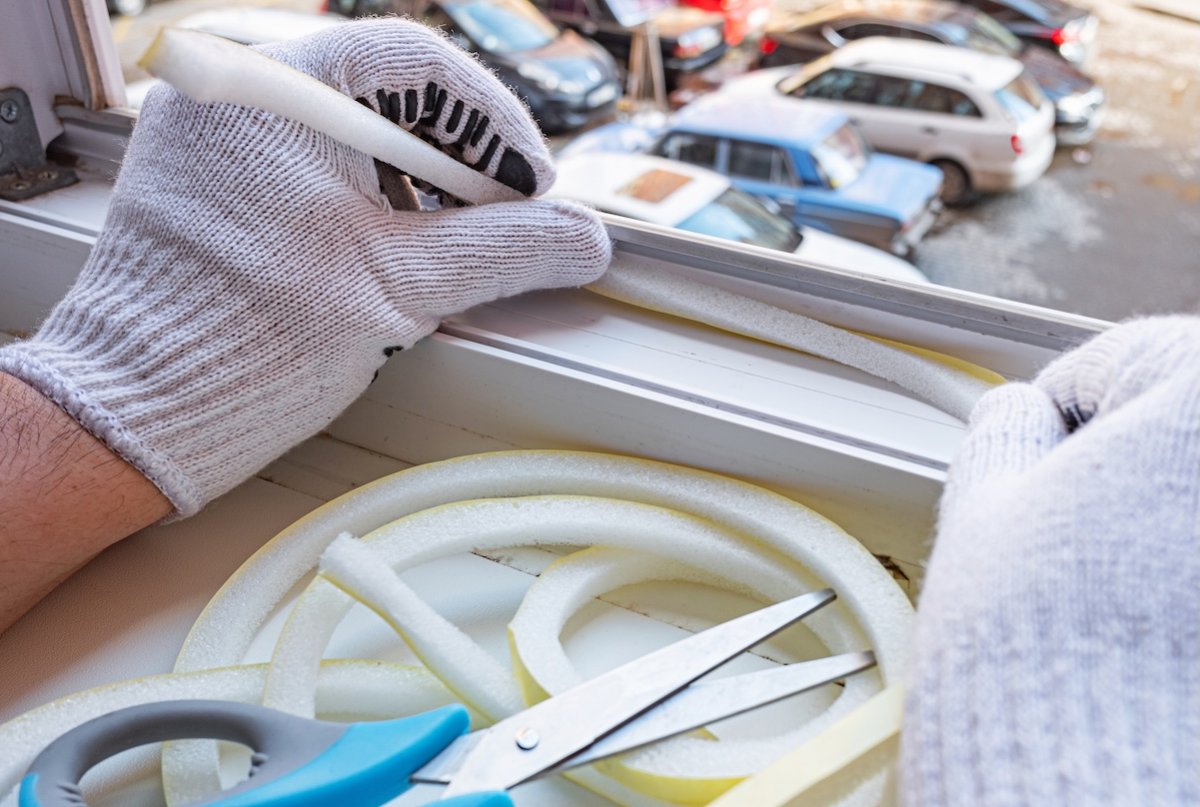

We may earn revenue from the products available on this page and participate in affiliate programs. Learn More ›
Weatherstripping is a simple, effective way to seal gaps around doors and windows, keeping indoor air in and outdoor air out. Whether you’re trying to stay warm in winter or cool in summer, properly sealed openings help improve comfort and reduce energy loss. There are lots of ways to stop or prevent air leaks, and different types of weatherstripping work best for different materials and scenarios.
Why invest in weatherstripping?
Weatherstripping is more than just a method to stop a draft—it’s one of the most cost-effective ways to cut energy waste. According to the U.S. Department of Energy, sealing air leaks with weatherstripping and caulk can reduce annual heating and cooling costs by 5 to 30 percent each year.
Key Benefits
- Lower utility bills: Less air leakage means the HVAC doesn’t have to work as hard.
- Improved comfort: Fewer cold drafts support more consistent indoor temperatures.
- Reduced noise and pests: Sealing gaps helps block sound, insects, and outdoor air.
- Better indoor air quality and humidity control: Minimizing leaks helps you maintain healthier, more stable indoor conditions.
- Environmental impact: Using less energy lowers your carbon footprint.
Common Types of Weatherstripping and How to Use Them
These types of weatherstripping are designed to seal gaps around doors, windows, or other openings. Each variety has its strengths, making it better suited for certain areas of the home. Below, we’ll cover the most common options, what they’re best for, and which products are worth considering.
1. Tape Weatherstripping
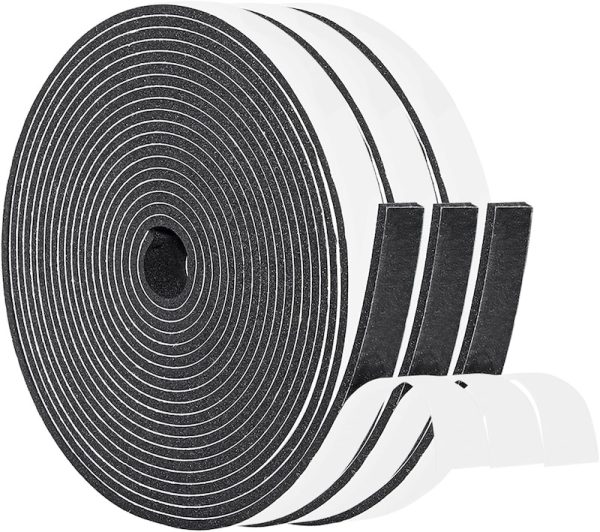
Tape weatherstripping is one of the most versatile and user-friendly options for sealing gaps. It typically comes in rolls of foam, rubber, or vinyl with an adhesive backing, making it easy to cut to size and press into place. Homeowners often use it on window sashes and the tops or sides of doors where gaps are small to medium in size. While tape is affordable and simple to install, it tends to wear down faster than more permanent solutions and might need to be replaced every year or two, especially in high-traffic areas.
Best for: Quick, inexpensive fixes on windows and doors.
Our recommendation: Yotache Adhesive Foam Tape at Amazon for $11.99
This self-adhesive foam tape is easy to apply, comes in different thicknesses, and provides a reliable seal against drafts at a budget-friendly price.
2. V-Strips
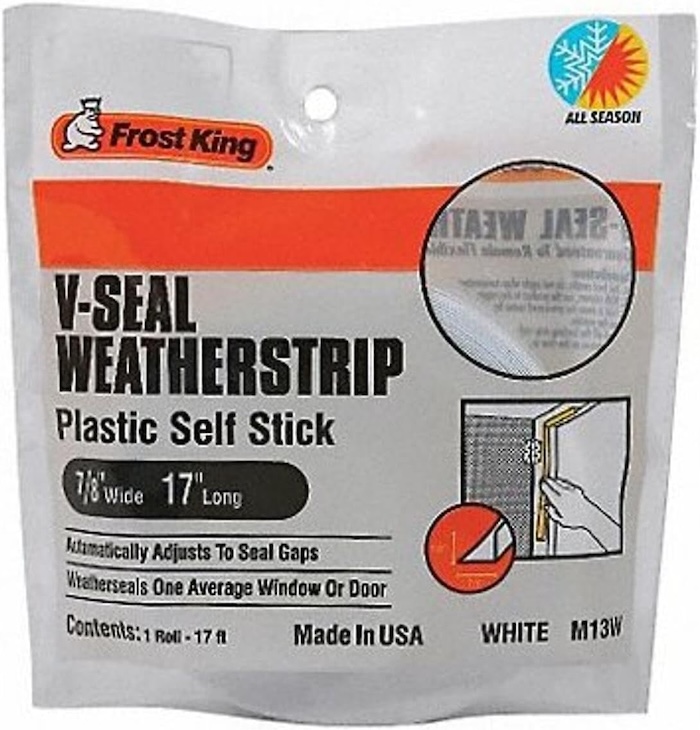
Also called tension seals, V-strips are thin lengths of durable vinyl or metal folded into a “V” shape. When installed along the sides of a window sash or doorjamb, the strip compresses to create a tight seal as the surface closes. Vinyl V-strips are inexpensive and easy to install since many come with self-adhesive backing. Metal versions are more durable and secure but require nails for installation. Either option is highly effective at sealing gaps where doors and windows slide or meet, especially on double-hung windows.
Best for: Sealing gaps on windows and door jambs where surfaces slide or press together.
Our recommendation: Frost King V-Seal Weatherstrip at Amazon for $4.88
This self-stick vinyl strip installs quickly, flexes with movement, and provides a long-lasting seal against drafts without interfering with window or door operation.
3. Gaskets
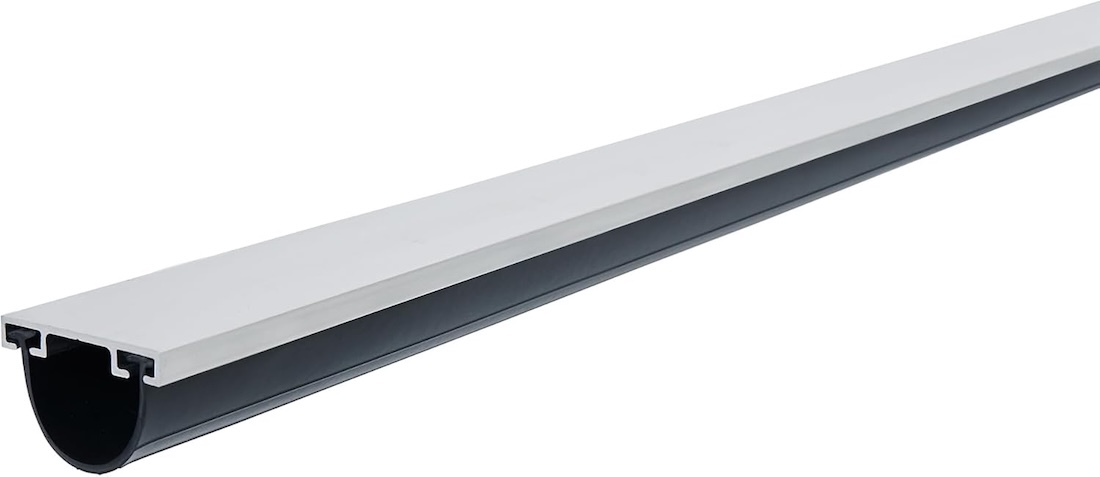
Gasket-style weatherstripping is typically tubular and rubber-like, designed to create a strong seal between a door and the surface below it. Most often used on garage doors, gaskets close off the gap between the bottom of the door and the concrete slab, preventing drafts, pests, and water from seeping inside. They can be attached with adhesive, nails, or screws, and some models slide into an existing track on the garage door. Gaskets can also serve as an alternative to a door sweep on exterior entry doors.
Best for: Sealing the bottom of exterior and garage doors against drafts and moisture.
Our recommendation: M-D Universal Aluminum and Vinyl Garage Door Bottom at Amazon for $22.93
This heavy-duty gasket combines aluminum for stability with a flexible rubber seal, making it a durable and effective way to keep garages weathertight.
4. Sweeps
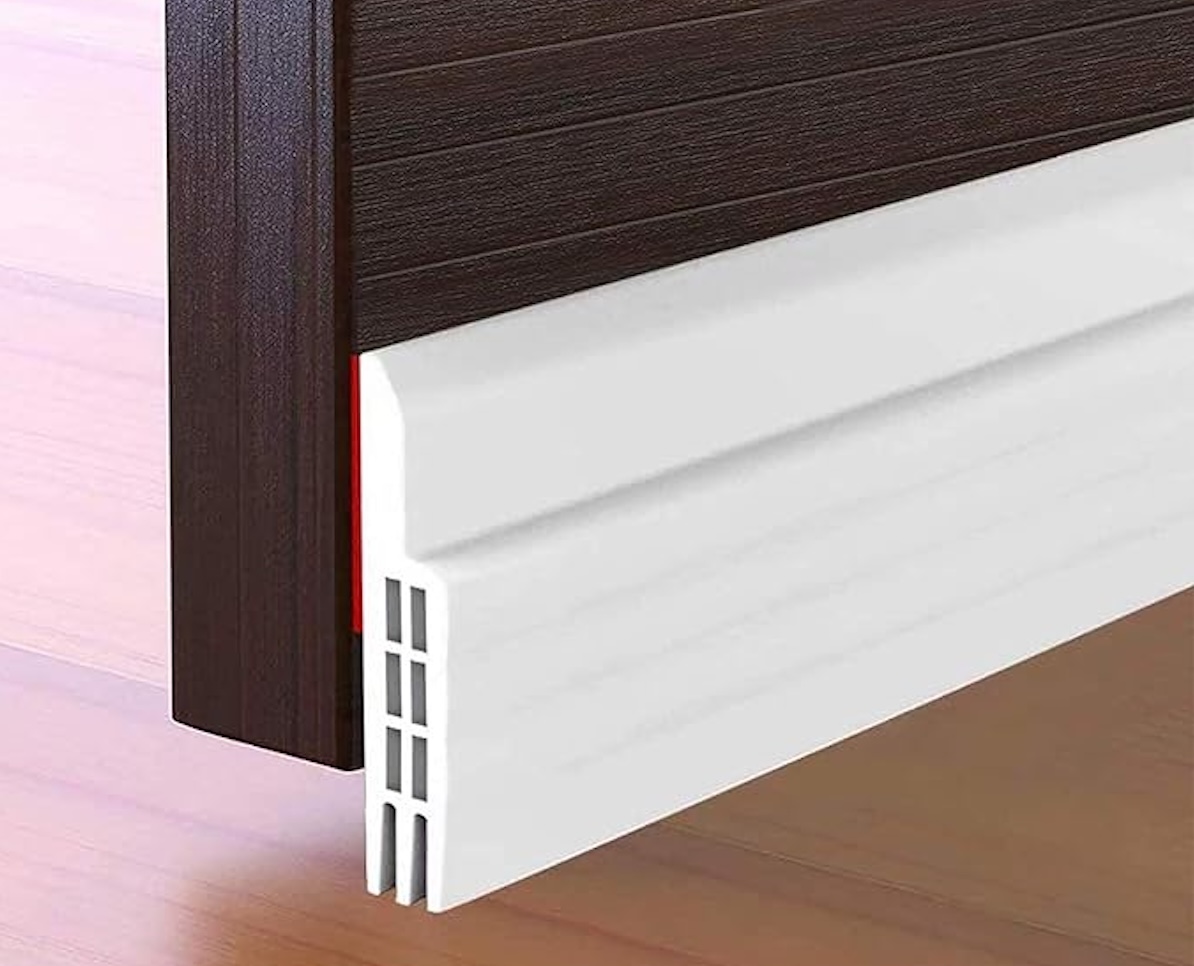
Door sweeps are strips of vinyl, rubber, or bristles attached to a backing that mount along the bottom edge of an exterior door. When the door is closed, the sweep presses against the threshold to block drafts, dust, insects, and even light. Some versions attach with adhesive for quick installation, while others are secured with screws for a more permanent hold. Sweeps may be installed on either the interior or exterior side of the door, depending on the product design and manufacturer’s instructions.
Best for: Blocking drafts at the bottom of exterior doors.
Our recommendation: Suptikes Exterior/Interior Door Seal at Amazon for $9.99
This adhesive-backed sweep installs in minutes and features a flexible silicone edge that forms a reliable seal while still allowing doors to open and close smoothly.
5. Felt
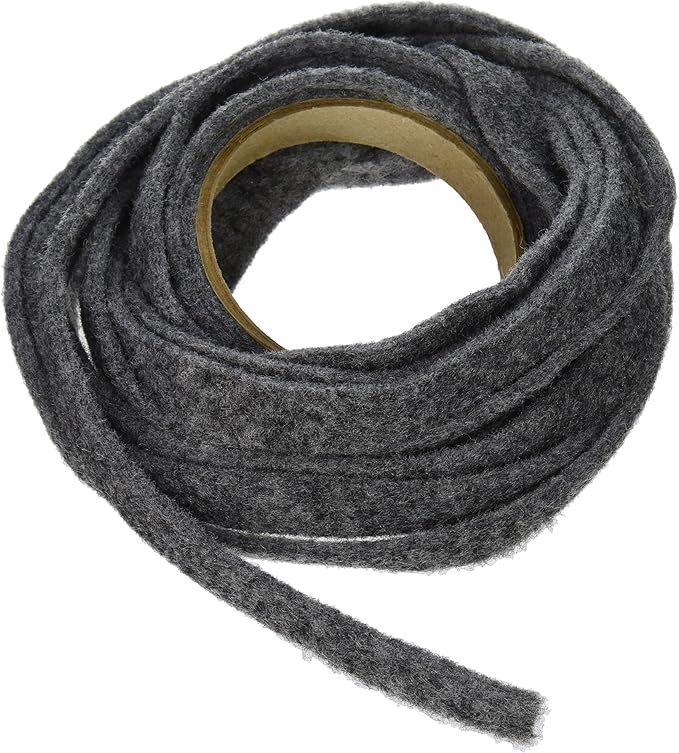
Felt weatherstripping is one of the oldest and most affordable options for sealing gaps. Typically sold in rolls, it consists of plain or reinforced felt with or without an adhesive backing. It’s easy to cut and staple, tack, or glue into place along window sashes, door frames, or attic hatches. Because felt is not as durable as rubber or vinyl, it’s best suited for low-traffic areas and spots where the seal isn’t exposed to constant friction or moisture. Homeowners often use it as a temporary solution or in spaces where cost is the main concern.
Best for: Low-cost sealing of windows, attic hatches, or low-traffic doors.
Our recommendation: Frost King Felt Weather Strip at Amazon for $9.68
This inexpensive roll installs quickly and is durable, making it a budget-friendly way to reduce drafts in out-of-the-way areas.
6. Reinforced Foam

Reinforced foam weatherstripping combines the flexibility of foam with a layer of plastic or metal facing that improves durability and longevity. Like standard foam tape, it typically comes with a self-adhesive backing for easy installation, but the added reinforcement helps it withstand repeated compression and exposure to the elements. For this reason, reinforced foam is a good choice for sealing uneven gaps around doors, windows, and attic hatches. It’s also available in a variety of thicknesses and widths, so homeowners can match the size of the strip to the size of the draft.
Best for: Sealing larger or uneven gaps on doors, windows, and attics.
Our recommendation: Storystore Foam Insulation Tape Self Adhesive at Amazon for $9.59
Available in multiple sizes, this reinforced foam tape sticks securely, adapts to irregular surfaces, and provides a longer-lasting seal than standard foam.
7. Rolled or Reinforced Vinyl Weatherstripping
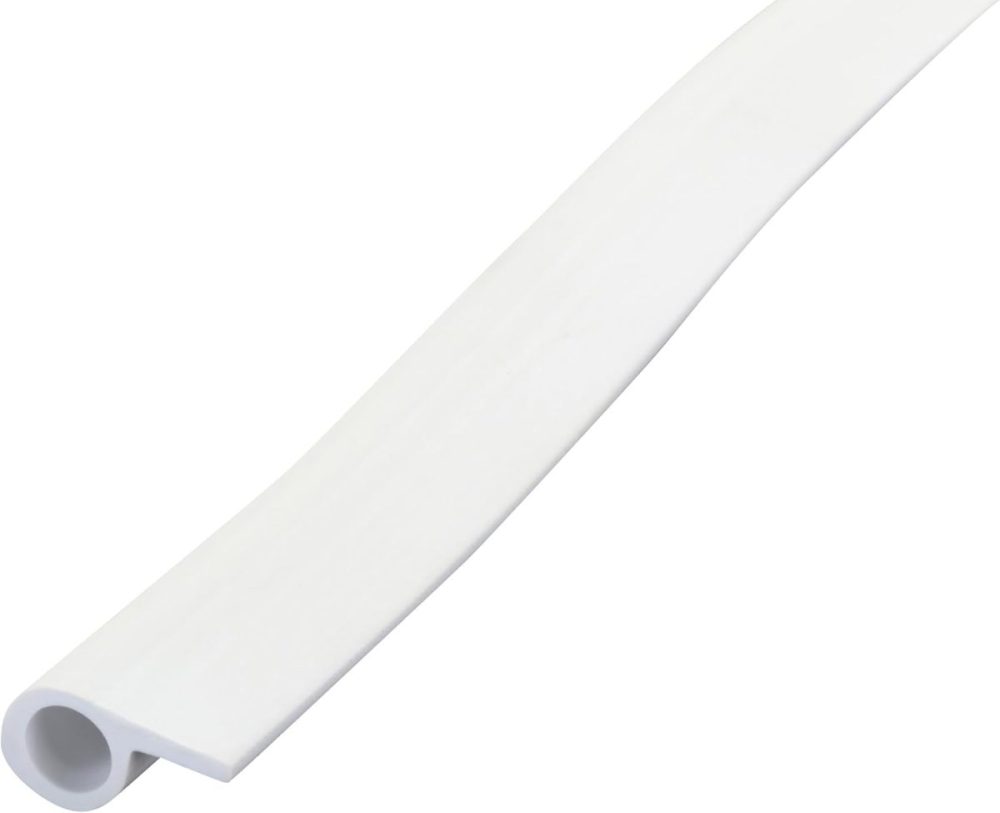
Rolled vinyl weatherstripping is flexible, durable, and resistant to moisture, so it is a common choice for sealing gaps in doors and windows. Often reinforced with a metal or wood carrier, this type of weatherstripping can be tacked, stapled, or nailed into place for a snug and lasting fit. It’s more durable than felt or plain foam and stands up well to repeated use and exposure, making it especially useful for exterior doors and windows. While installation can take a bit more effort than peel-and-stick products, the trade-off is better longevity and reliability.
Best for: Long-lasting seals on doors and windows exposed to frequent use or outdoor conditions.
Our recommendation: M-D Building Products White Vinyl Gasket Weatherseal at Amazon for $8.32
This reinforced vinyl strip is durable, flexible, and moisture-resistant, so it is a dependable option for high-traffic entryways.
8. Magnetic Weatherstripping

Magnetic weatherstripping uses a magnetic strip to create a tight seal between the edge of a metal door and its frame, working much like the gasket on a refrigerator. This design provides one of the most effective air barriers, a feature that is especially valuable for exterior doors where drafts and energy loss are most significant. While installation is a bit more involved than peel-and-stick options, the payoff is a highly durable, long-lasting seal that requires little maintenance. Magnetic weatherstripping is generally limited to metal doors, since it needs a ferrous surface to work properly.
Best for: Creating a strong, energy-efficient seal on exterior metal doors.
Our recommendation: TMH Magnetic Weather Stripping Door Seal at Amazon for $54.97
This high-quality set includes three pieces with an improved extra-strength magnet that ensures a reliable seal. Available in white or black, the strips can be trimmed to fit and are built for long-term performance.
9. Reinforced Silicone Weatherstripping
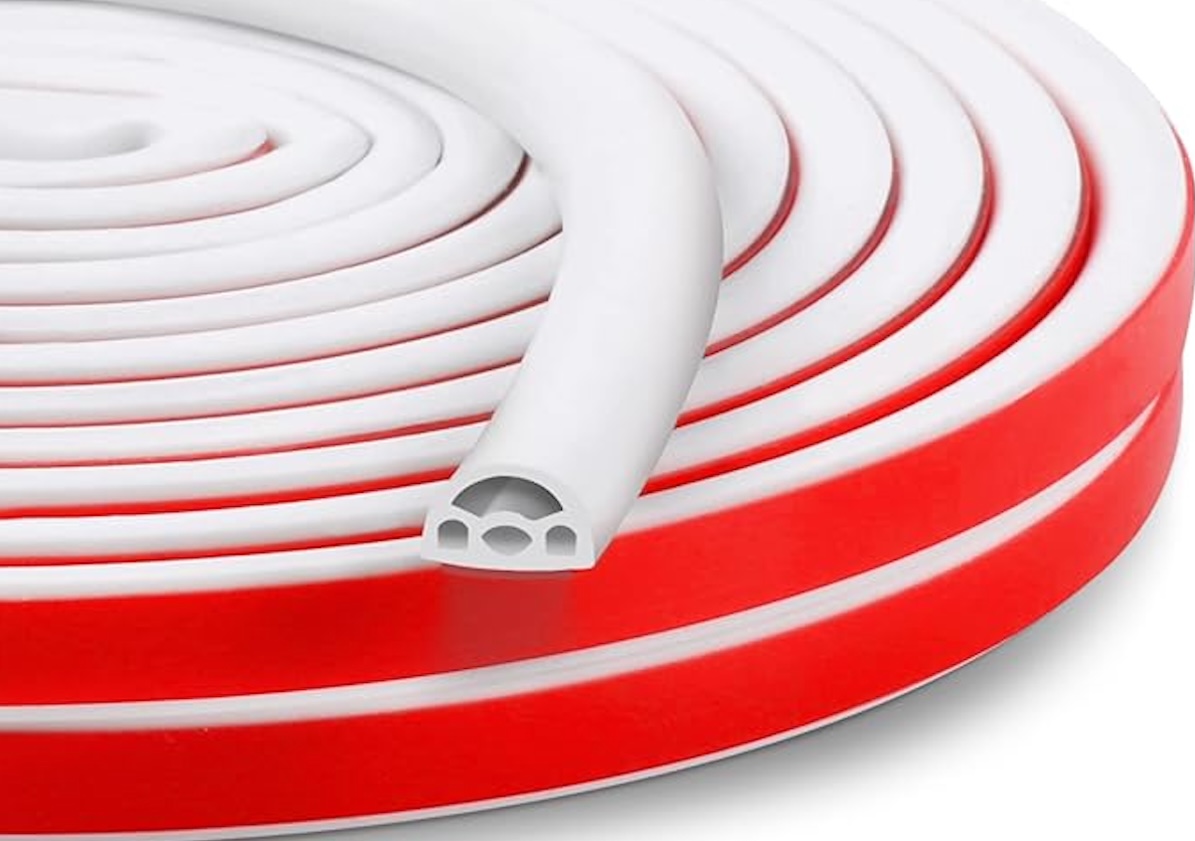
Since silicone weatherstripping is flexible, durable, and resistant to both temperature extremes and moisture, it is a reliable long-term solution for sealing doors and windows. Reinforced silicone strips often feature multiple layers or hollow chambers that compress when the door or window closes, creating a stronger barrier against drafts, dust, and noise. They’re easy to cut to size and apply with an adhesive backing, making them a versatile option for homeowners looking for something more durable than foam or felt.
Best for: Long-lasting seals on doors and windows, especially in humid or high-use areas.
Our recommendation: Benory Silicone Weather Stripping Door Seal at Amazon for $12.99
This multi-layered silicone strip provides excellent insulation against air, sound, and water. The adhesive backing makes installation simple, while the flexible design ensures a snug fit that lasts.
10. Tubular Rubber and Vinyl Weatherstripping
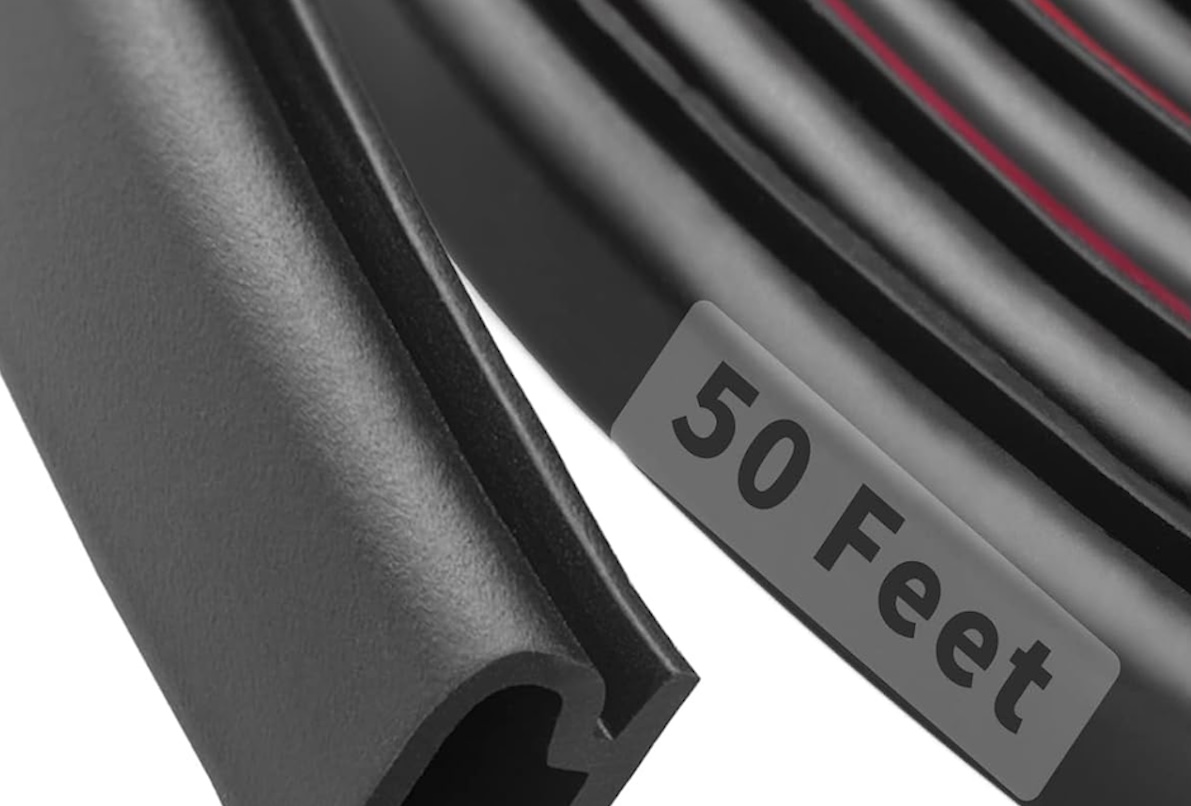
Tubular weatherstripping, often made from rubber or vinyl, uses a hollow, tube-like design that compresses to fill larger gaps around doors and windows. It provides an effective seal against drafts, moisture, and noise, while also holding up well to temperature extremes. Tubular strips are commonly installed around door frames or window casings with adhesive backing, tacks, or a metal carrier, depending on the style. They’re more durable than felt or foam and are an excellent choice for exterior doors where air leakage is most noticeable.
Best for: Durable sealing of medium to large gaps around doors and windows.
Our recommendation: Fingerwerk D-Shape Rubber Weatherstripping at Amazon for $19.99
This 50-foot roll includes scissors for easy cutting and features a strong self-adhesive backing. The flexible, D-shape design holds up in extreme temperatures for a dependable all-season draft stopper.
11. Door Shoes
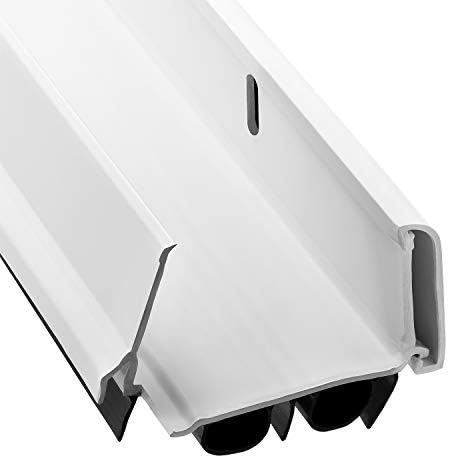
A door shoe is a type of weatherstripping that fits along the bottom edge of an exterior door, typically sliding onto the door itself rather than attaching to the threshold. Designed to create a tight seal, door shoes are especially effective at blocking drafts, moisture, and pests from entering under the door. Many models also include a drip cap to direct water away from the entry, offering added protection against leaks. While installation requires attaching the shoe with screws, most designs don’t require removing the door from its frame, so the process is easier than it looks.
Best for: Blocking drafts and moisture at the bottom of exterior doors.
Our recommendation: KS Hardware Adjustable Double Bubble Door Sweep at Amazon for $44.99
This adjustable shoe fits gaps from ⅜ to ⅞ inch, with a double-bubble design that ensures maximum contact with the threshold. Its built-in drip cap helps divert rainwater, and it installs easily without removing the door.
12. Bulb Thresholds
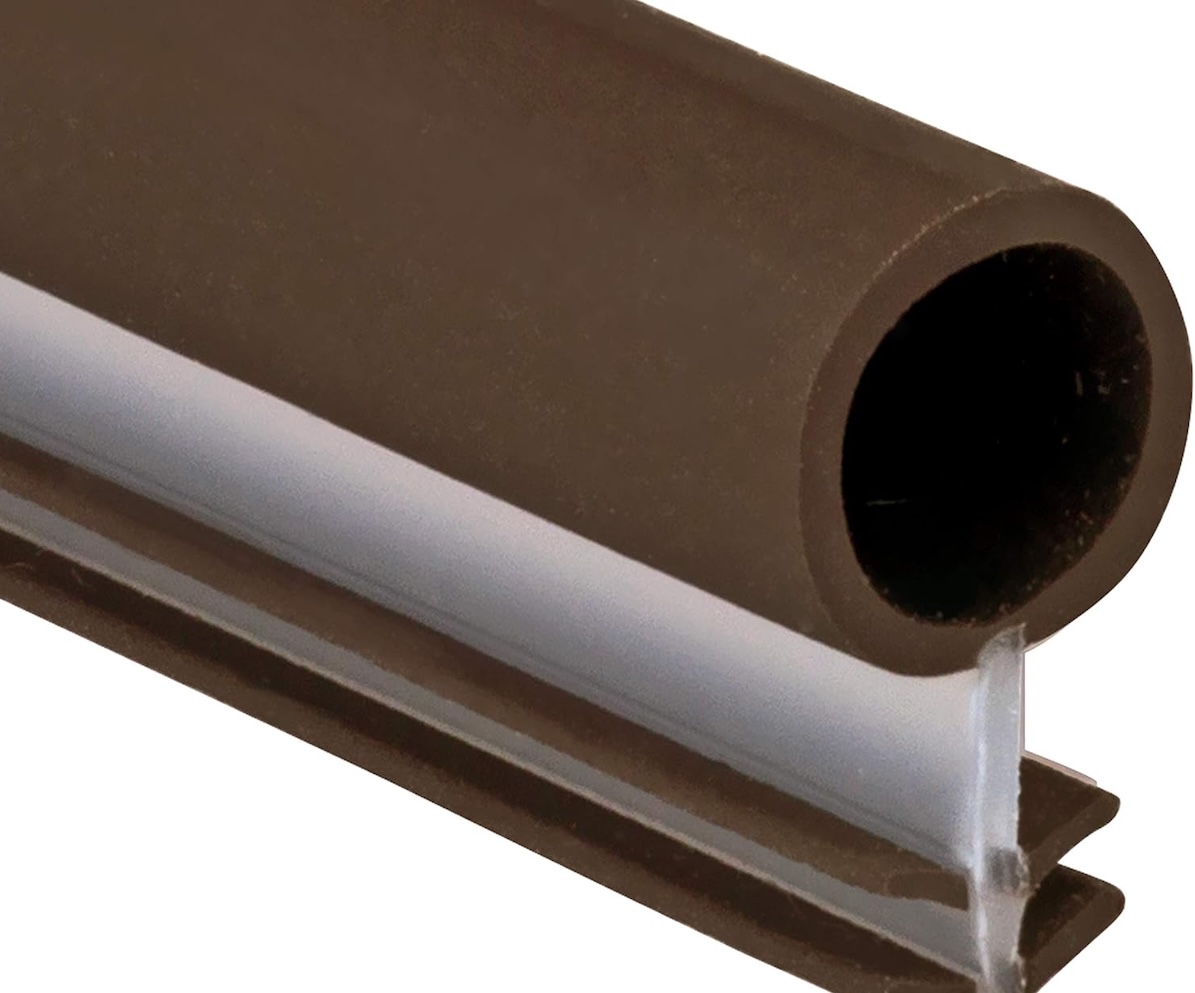
Bulb thresholds use a rounded, bulb-shape seal—often made of rubber, vinyl, or thermoplastic elastomer—that compresses when the door closes to create a tight barrier. Designed to fit into a kerf (a slot along the door frame), bulb thresholds are effective at blocking drafts, insects, and moisture while allowing the door to open and close smoothly. They’re commonly used on exterior entry doors and are available in different sizes to match the gap at the bottom of the door. Since they compress evenly, bulb thresholds offer a reliable, long-lasting seal that doesn’t wear down quickly.
Best for: Creating a snug, flexible seal at the base of exterior entry doors.
Our recommendation: Seal Supply Window Weatherstrip Seal 1/4″ Bulb Bubble Kerf Mount at Amazon for $13
Made in the U.S. from durable thermoplastic elastomer, this kerf-mount bulb seal comes in four colors and six lengths to fit most doors. Its flexible ¼-inch bulb design ensures an effective seal against air, water, and pests.
13. Frost-Brake Thresholds
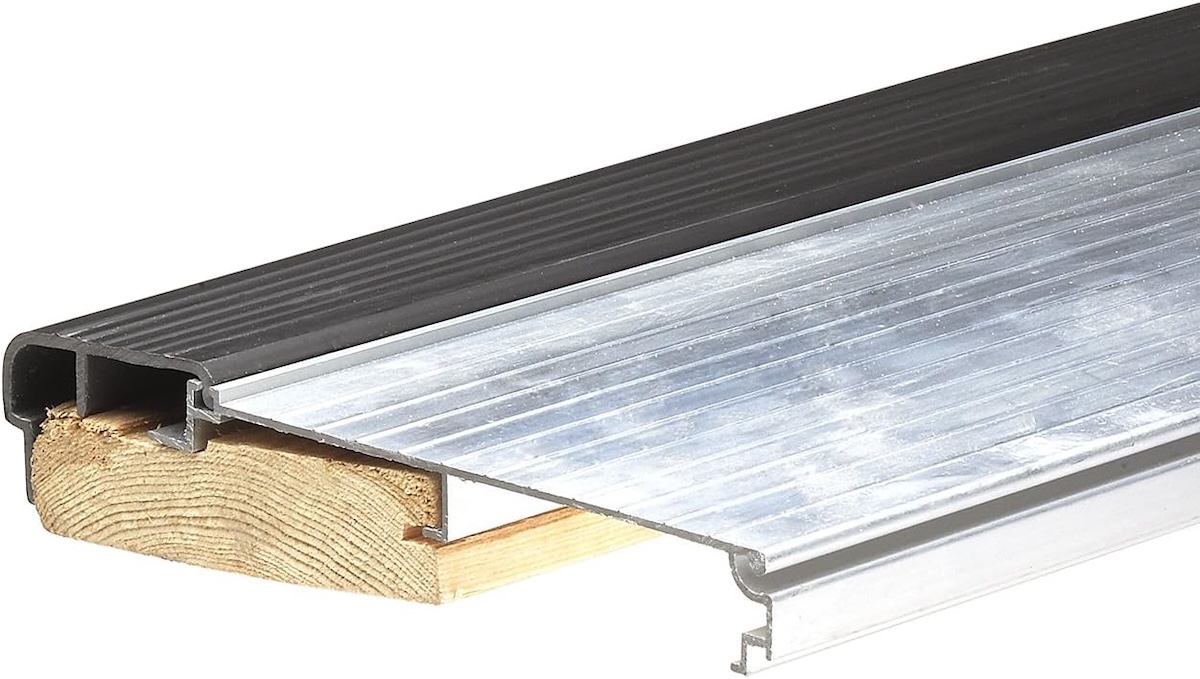
Frost-brake thresholds are designed to prevent cold air from transferring through the threshold itself, which can happen with standard aluminum sills. They typically feature a thermal barrier—often a vinyl or composite insert—that breaks the connection between the inside and outside surfaces of the threshold. This design helps reduce drafts and energy loss, particularly in colder climates where metal thresholds can conduct heat. Frost-brake thresholds are a smart upgrade for exterior entry doors, combining durability with better insulation.
Best for: Preventing heat loss and cold air transfer through exterior door thresholds.
Our recommendation: Frost King Heavy-Gauge Aluminum Sill Threshold at Amazon for $34.99
Made of heavy-gauge aluminum with a vinyl thermo-barrier insert, this fixed sill fits doors up to ¾ inch high. Its durable, low-profile design improves insulation while adding a clean, finished look to entryways.
14. Fin Seals
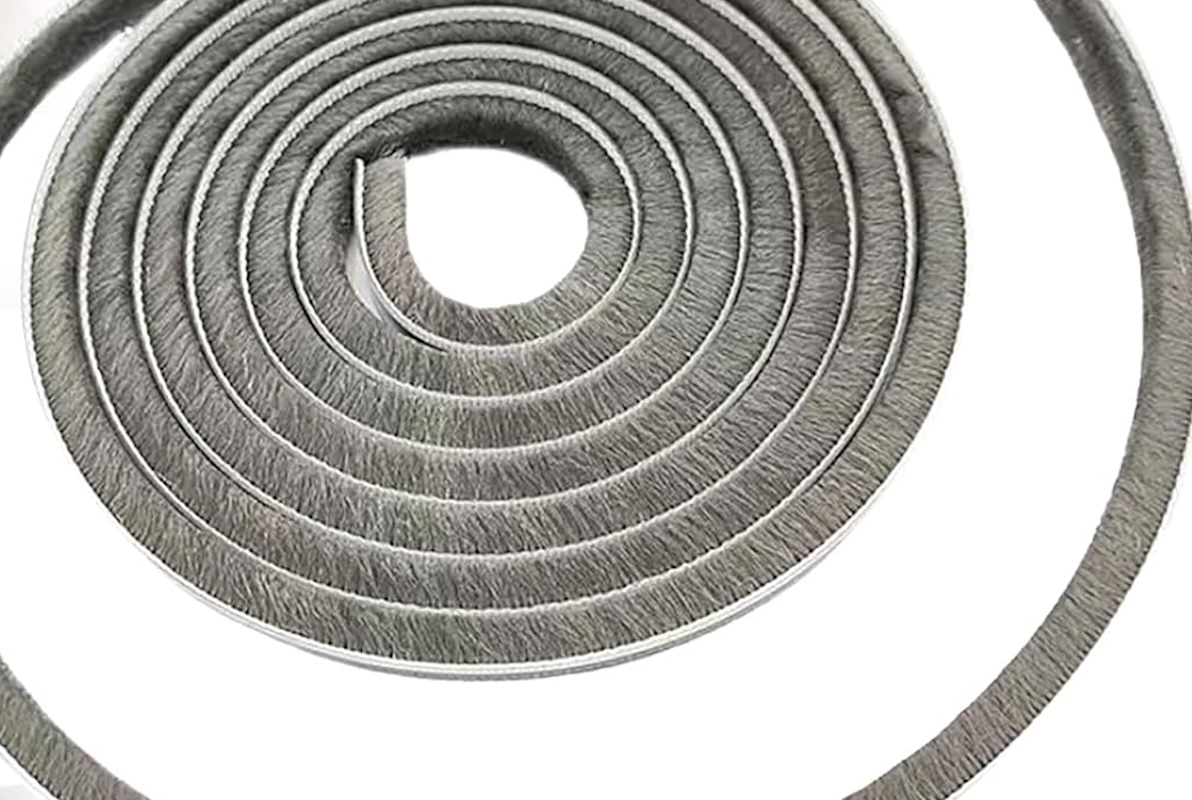
Fin seals, often used on sliding or glass doors, feature a row of dense bristles with a flexible center fin that helps block air, dust, and moisture. The brush-like material compresses to fill narrow gaps while the fin adds an extra barrier against drafts. Fin seals are a popular choice for sliding patio doors, sliding windows, or wardrobe doors because they allow smooth operation without interfering with movement. They also help reduce noise and can be trimmed to size for a custom fit.
Best for: Sealing sliding doors and windows without restricting movement.
Our recommendation: Soezy Brush Seal Strip at Amazon for $9.99
This flexible brush seal strip installs easily and reduces noise, dust, and drafts without affecting door or window operation. It is easy to cut to size, bendable, and made from durable, environmentally friendly materials for long-lasting performance.
15. Interlocking Metal Channels
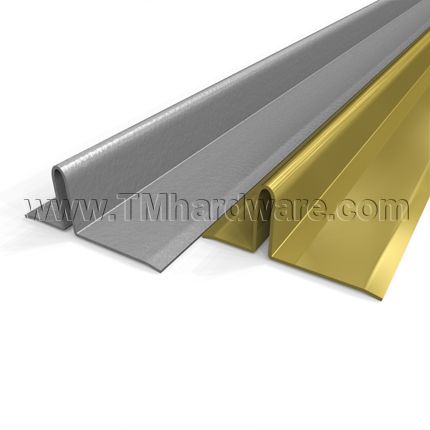
Interlocking metal channels are one of the most durable and airtight forms of weatherstripping. This system uses two metal strips—one attached to the door or window, the other to the frame—that interlock when closed, creating a mechanical seal that’s highly effective at blocking air, water, and noise. Because of their strength, they’re often used on exterior doors that face severe weather or heavy drafts. Installation is more involved than adhesive-backed products, but the payoff is a long-lasting, professional-grade seal that can dramatically improve energy efficiency.
Best for: Heavy-duty sealing of exterior doors in areas with severe weather.
Our recommendation: Pemko Interlocking Metal Weatherstrip at Trademark Hardware for $47.24
This premium interlocking system provides an exceptionally tight seal, so it is ideal weatherstripping for homes that need maximum draft protection. While not widely available through major retailers, it’s a durable, high-performance option worth seeking.
Weatherstripping Tips and Guidance
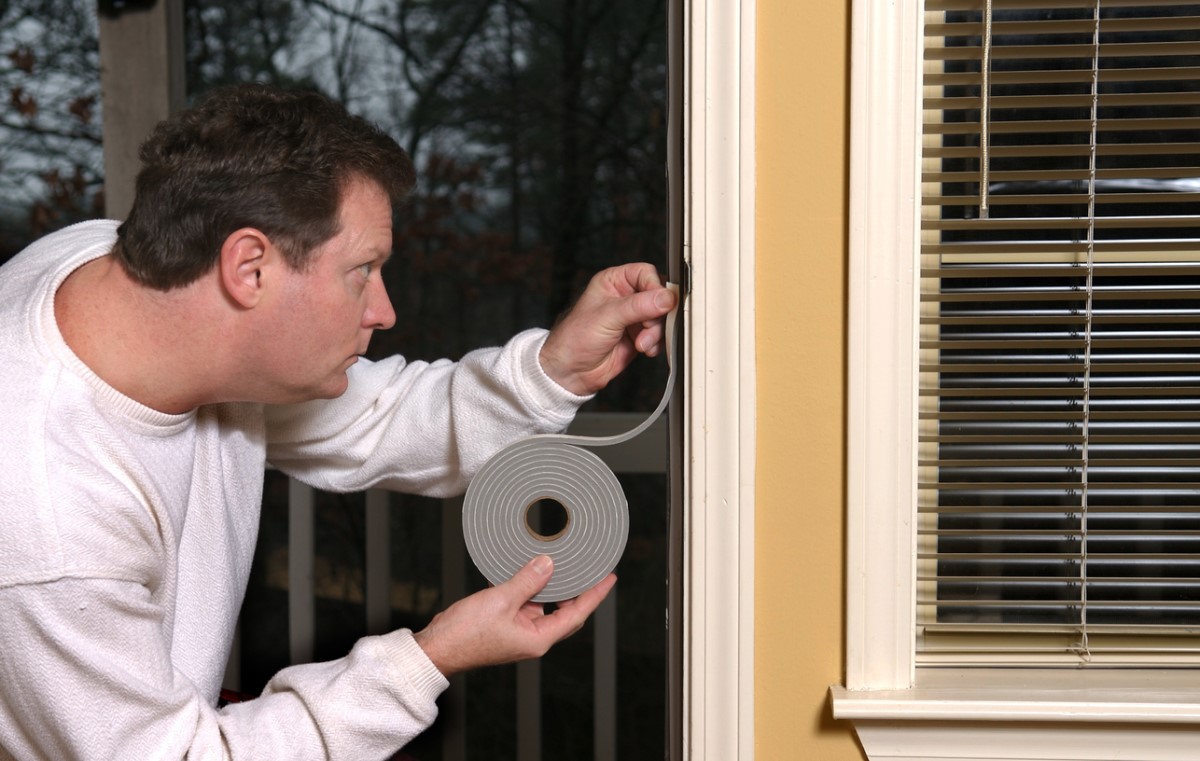
Weatherstripping is one of the simplest and most effective ways to improve a home’s energy efficiency, but a few guidelines can help you get the best results. Before installing, always inspect doors and windows for cracks or leaks, clean the surfaces thoroughly, and choose the right material for the size of the gap. The Department of Energy also recommends checking weatherstripping once a year, since heavy use and exposure to the elements can cause materials to wear out.
Weatherstripping for Doors
Exterior doors are among the most common sources of air leaks. Adding or replacing door weatherstripping can dramatically improve comfort and cut down on energy loss.
- Look for daylight around the edges of closed doors: If you see it, you need new weatherstripping.
- Use sweeps or shoes for the bottom gap, and strips or gaskets along the sides and top.
- Check the seal annually and replace worn materials as needed.
- For more step-by-step detail, see how to install weather stripping on a door.
Weatherstripping Windows
Windows can leak air even when closed, especially in older or poorly fitted frames. Proper window weatherstripping ensures tighter seals and better insulation.
- Add V-strips or foam tape to sashes where windows slide or press into the frame.
- Check for rattling panes or drafts on windy days to identify weak points.
- Combine weatherstripping with caulk around the frame for maximum air sealing.
- Replace worn tape or felt strips every year or two, especially in high-use windows.
Garage Door Weatherstripping
Garage doors are large, heavy, and often leave significant gaps at the bottom, sides, or between panels. Sealing these spaces helps keep the garage and adjacent rooms more comfortable.
- Install a threshold or gasket along the bottom to block drafts and water.
- Check side and top seals for wear and replace if light shows through.
- In colder climates, consider heavy-duty or reinforced options for long-lasting protection.
- For product recommendations, see our guide to the best garage door thresholds.
Final Thoughts
Weatherstripping is an inexpensive home upgrade that pays off in comfort, energy savings, and durability. By choosing the right type for each door or window and following a few best practices, you can eliminate drafts and improve your home’s efficiency year-round. For more step-by-step advice, read guide about how to fixing a drafty window.
Prices listed in this article are accurate as of October 9, 2025.
